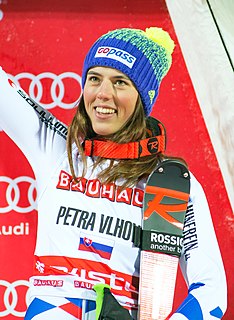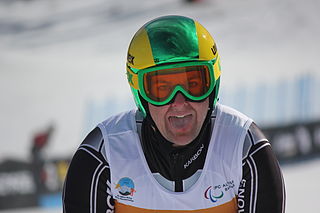 W
W'Alpine skiing, or downhill skiing', is the pastime of sliding down snow-covered slopes on skis with fixed-heel bindings, unlike other types of skiing, which use skis with free-heel bindings. Whether for recreation or for sport, it is typically practiced at ski resorts, which provide such services as ski lifts, artificial snow making, snow grooming, restaurants, and ski patrol.
 W
WThe Women's Giant Slalom World Cup 2020/2021 involved 8 events including the final. After seven events, Marta Bassino had clinched the crystal globe for the season.
 W
WThe Women's Slalom World Cup 2020/2021 involved 9 events including the final. After six events, defending 2020 World Cup slalom champion Petra Vlhová led a tight five-person race for the crystal globe.
 W
WThe Women's Super-G World Cup 2020/2021 involved 7 events including the final. Swiss skier Lara Gut-Behrami clinched the discipline title for 2021 after the sixth event.
 W
WThe Crazy Canucks was the nickname for a group of World Cup alpine ski racers from Canada who rose to prominence in the 1970s and 1980s. Jungle Jim Hunter, Dave Irwin, Dave Murray, Steve Podborski, and Ken Read earned themselves a reputation for fast and seemingly reckless skiing in the downhill event.
 W
WDownhill is a form of alpine skiing competition. Whereas the other alpine skiing events emphasize turning and technique, downhill emphasizes "the six components of technique, courage, speed, risk, physical condition and judgement", according to the FIS "International Ski Competition Rules (ICR)". Speeds of up to 130 km/h (81 mph) are common in international competition. Athletes must have an aerodynamically efficient tuck position to minimize drag and increase speed.
 W
WIn mountain biking and skiing, a fall line refers to the line down a mountain or hill which is most directly downhill; that is, the direction a ball or other body would accelerate if it were free to move on the slope under gravity. In mountain biking, a trail follows the "fall line" if it generally descends in the most downward direction, rather than traversing in a sideways direction. A skier is said to be "skiing the fall line" if he or she is moving generally down, making turns either side of the fall line, rather than moving across the slope. Mathematically the fall line, the line of greatest slope, is the negative of the gradient and perpendicular to the contour lines.
 W
WFreeskiing, or new school skiing is a specific type of alpine skiing, which involves tricks, jumps, and terrain park features, such as rails, boxes, jibs, or other obstacles. This form of skiing resulted from the growth of snowboarding combined with the progression of freestyle skiing. "Newschoolers", or those who specifically ski in this style, as opposed to traditional freestylers, freeriders, big mountain skiers, and racers, are often found in terrain parks, which are designed specifically for tricks.
 W
WGiant slalom (GS) is an alpine skiing and alpine snowboarding discipline. It involves skiing between sets of poles (gates) spaced at a greater distance from each other than in slalom but less than in Super-G.
 W
WGrass skiing, skiing on grass, is a method for training for alpine skiing. Both grass skiing and alpine skiing have become established as sports in their own right. The skis used for grass skiing are short with rolling treads or wheels. These skis are attached to the skiers' boots. Depending on the skill of the grass skier, high speeds and jumps can be navigated.
 W
WLW1 is a para-Alpine standing skiing classification for people with severe lower extreme disabilities in both extremities. It includes both skiers with amputations and cerebral palsy. International classification is done through International Paralympic Committee Alpine Skiing, and national classification through local national sport federations. LW1 classified skiers use outriggers, and two skis or one ski with a prosthesis. Other equipment is used during training such as ski-tips, ski-bras, and short skis.
 W
WLW2 is a para-Alpine and para-Nordic standing ski sport class defined by the International Paralympic Committee (IPC). Competitors in this class have severe disability in a lower limb, which may be a result of an amputation, or arthrodesis in the leg and hip. Depending on the type of skiing, the international classification process for LW2 skiers is handled by the IPC Alpine Skiing Technical Committee and IPC Nordic Skiing Technical Committee. National sport federations handle classification on the lower levels.
 W
WLW10 is a para-Alpine and para-Nordic sit-skiing classification for skiers who cannot sit up without support. For international skiing competitions, classification is conducted by International Paralympic Committee (IPC) Alpine Skiing and IPC Nordic Skiing, while national federations such as Alpine Canada handle classification for domestic competitions.
 W
WLW11 is a para-Alpine and para-Nordic sit skiing sport class, a classification defined by the International Paralympic Committee (IPC for people with paralysis in the lower extremities and people with cerebral palsy that affects the lower half of the body. Outside of skiing, the competitor in this class is unable to walk. For international competitions, classification is done through IPC Alpine Skiing or IPC Nordic Skiing. For sub-international competitions, classification is done by a national federation such as Alpine Canada.
 W
WParalympic alpine skiing is an adaptation of alpine skiing for athletes with a disability. The sport evolved from the efforts of disabled veterans in Germany and Austria during and after the Second World War. The sport is governed by the International Paralympic Committee Sports Committee. The primary equipment used includes outrigger skis, sit-skis, and mono-skis. Para-alpine skiing disciplines include the Downhill, Super-G, Giant Slalom, Slalom, Super Combined and Snowboard.
 W
WSlalom is an alpine skiing and alpine snowboarding discipline, involving skiing between poles or gates. These are spaced more closely than those in giant slalom, super giant slalom and downhill, necessitating quicker and shorter turns. Internationally, the sport is contested at the FIS Alpine World Ski Championships, and at the Olympic Winter Games.
 W
WSuper giant slalom, or super-G, is a racing discipline of alpine skiing. Along with the faster downhill, it is regarded as a "speed" event, in contrast to the technical events giant slalom and slalom. It debuted as an official World Cup event during the 1983 season and was added to the official schedule of the World Championships in 1987 and the Winter Olympics in 1988.